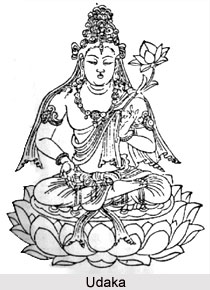 Udaka was one of the teachers to whom Gautama Buddha or Bodhisattva went to know more about Dhamma. Udaka is also referred to as Ramaputta or the disciple of Rama. However by the time young Gautama went to Udaka Rama had already passed away. Before going to Udaka Buddha was with Alara Kalama. He was searching for the path to attain nirvana. It is at this time that the fame of Udaka reached him and he became his follower. It was here that the concept of Dhamma was explained to him. The Bodhisattva was so impressed by this doctrine that he it became one of the founding stones for Buddhism.
Udaka was one of the teachers to whom Gautama Buddha or Bodhisattva went to know more about Dhamma. Udaka is also referred to as Ramaputta or the disciple of Rama. However by the time young Gautama went to Udaka Rama had already passed away. Before going to Udaka Buddha was with Alara Kalama. He was searching for the path to attain nirvana. It is at this time that the fame of Udaka reached him and he became his follower. It was here that the concept of Dhamma was explained to him. The Bodhisattva was so impressed by this doctrine that he it became one of the founding stones for Buddhism.
In the Buddhist canonical texts detailed accounts of conversations between Buddha and Udaka are mentioned. On learning that Rama had completed all the eight stages of jhana, Buddha too decided to achieve the same. According to him like Rama he too had the determination, faith and diligence to achieve the ultimate stage of jhana-`Neither Perception nor Non-Perception.` In these texts it is also mentioned that at a certain point of time Udaka looked up at Buddha as a teacher. He had even asked Buddha to lead his group. Udaka was of the opinion that if Buddha could achieve what Rama did then there was no difference between the two personages.
In Theravada literature there is no reference to Udaka`s dwelling place but Buddha`s biography, Lalitavistra, confirms that he resided in the Rajagaha district. He had around 700 followers. It is said that Udaka himself had not attained the stage of `Neither Perception nor Non-Perception` when he met Gautama. He was instrumental in explaining to the Bodhisattva the path to achieve Dhamma.
Within a short time span Bodhisattva became disillusioned with the doctrine because he was looking for a way to escape the defilements of mind and nirvana. Hence he left Udaka`s center to pursue his own path.




















